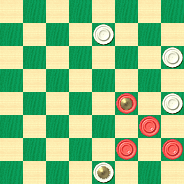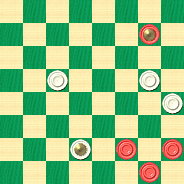Deans, Pearson, and Quinlan: Laying Down the Law in Checkers

Deans, Pearson, and Quinlan: It sounds more like the trio of lawyers shown above than a trio of checkerists credited with thematically related studies, but checkerists they were. We really don't know whether one or more of them might have been lawyers during their time in the mid-to-late 1800s; we suppose it's possible, but we didn't come up with any further information.
We can confidently say, however, that the three positions diagrammed below are eminently practical and, as the latest entries in our Checker School series, well worth your time to master. All positions are shown with White at the top for ease in comparison.
E. DEANS

BLACK
White to Play and Draw
W:W26,21,13,K2:BK14,9,6,5.
WHITE

BLACK
Black to Play and Win
B:W19,17,13,K7:BK25,6,5,1.
WHITE

BLACK
Black to Play and Win
B:W15,13,K7:BK14,9,6,1.
These studies "lay down the law," so to speak, for endings of this type. Do your best to find the right moves--- legal moves, of course--- to make your case, then click on Read More for the definitive judgments, including sample games, detailed notes, and a supplementary problem.![]()
Solutions
Solutions, sample games, supplementary material, and lettered notes are taken as usual from Ben Boland's Famous Positions in the Game of Checkers. Numbered notes are by the Editor using the KingsRow computer engine.
Diagram No. 1: 21-17, 14-21, 26-23, 21-17, 23-19, 17-14, 19-16---A, 14-10, 16-12, 10-15, 12-8, 15-11,8-3. Drawn---1.
Diagram No. 2: 5-9---2, 7-2, 25-21, 19-15---I, 21-14, 2-7. Forms Diagram No. 3.
Diagram No. 3: 1-5, 7-2, now same as Note A after first move, 6-10, 15-6, 14-10, 6-1, 10-15, 13-6, 15-11. Black Wins.
Game: 11-15, 22-18, 15-22, 25-18, 8-11, 29-25, 4-8, 24-20, 10-15, 25-22, 15-19, 23-16, 12-19, 27-23, 8-12, 23-16, 12-19, 31-27, 3-8, 27-23, 8-12, 23-16, 12-19, 32-27, 6-10, 27-23, 11-16, 20-11, 7-16, 18-15, 9-14, 15-6, 2-9, 23-18, 14-23, 28-24, 19-28, 26-12, 28-32, 12-8, 32-27, 8-3, 27-23, 3-7, 1-6, 7-2, 23-19, 22-17, 19-15---B, 17-13, 15-10, 30-26---C, 10-14. Forms Diagram No. 1, E. Deans. Game Mo. 267, Draughts World, May 1894, Vol. 3. See history below.
Game: 11-15, 23-19, 8-11, 22-17, 9-14, 25-22, 11-16, 26-23---D, 16-20, 31-26, 6-9---E, 17-13, 14-18, 13-6, 2-9, 23-14, 9-25, 29-22, 4-8, 26-23, 8-11, 22-17, 5-9, 17-14, 9-18, 23-14, 10-17, 21-14, 7-10, 14-7, 3-10, 30-26, 1-6, 26-22, 6-9, 22-18, 15-22, 19-16, 12-19, 24-6, 22-26, 6-2, 26-30, 2-7, 11-16, 7-11, 30-26, 11-8, 9-14---F. Forms Diagram No. 2, colors reversed. F. A. Marsh vs. J. B. Pearson, Game No. 120, American Checker Review, Feb. 16, 1883, Vol. 1.
Game: 11-15, 22-18, 15-22, 26-17, 8-11, 31-26, 4-8, 25-22, 11-15, 29-25, 15-19, 24-15, 10-19, 23-16, 12-19, 17-13, 9-14, 22-17, 8-12, 17-10, 6-15, 25-22, 7-10, 22-17, 2-6---G, 27-24, 15-18, 24-15, 10-19, 17-14, 12-16, 26-23, 18-27, 32-23, 19-26, 30-23, 16-20, 23-19, 20-24, 19-16, 24-27, 16-11, 27-31, 21-17, 31-26, 11-7, 2-11, 14-7, 26-22, 7-3, 5-9, 3-7, 22-25, 28-24, 25-21, 24-19, 21-14, 19-15---H. Forms Diagram No. 3. W. Veal and H. T. Smith, Games No. 396 and 397, Eastern Weekly Press. Sept. 5, 1903.
Game: 11-15, 24-19, 15-24, 28-19, 8-11, 22-18, 11-16, 25-22, 16-20, 22-17, 4-8, 17-13, 8-11, 26-22, 10-14, 19-15, 12-16, 15-8, 3-12, 22-17, 7-10, 29-25, 16-19, 23-16, 14-23, 27-18, 12-19, 17-14, 10-17, 21-14, 2-7, 25-22, 19-24, 22-17, 7-11, 30-26, 24-27, 32-23, 11-15, 18-11, 9-27, 31-24, 20-27, 26-23, 27-31, 23-19, 31-26, 11-7, 26-22, 7-3, 22-25, 3-7. Forms Diagram No. 2. Ketchum's Handy Manual.
A---19-15, 6-10, 15-6, 14-10, 6-1, 10-15, 13-6, 15-11. Black Wins.
B---The experts thought McKerrow should have scored a win by this move instead of 9-13.
C---21-17, 10-15, 2-7, 15-10, 7-14, 9-18, 30-25, 18-23, 25-22, 23-26, 22-18, 26-30, 17-14, 30-26, etc. Black Wins. Drummond and Perry.
D---The Glasgow refused, which is very weak.
E---A poor move.
F---Pearson also points out the Deans' Position, saying that it was No. 1, National Checker Journal, also No. 701, Turf. With a man on 26 instead of a King the position may be found in the Leeds Mercury, July 1894 by X,P. B." (Peter Bennett). The continuation is the same.
G---This move was given to correct Lees' Guide, but a draw was shown after it.
H---Now Gem No. 469 in the Draughts World, Sept. 1903, Vol. 22. W. Veal and H. T. Smith sent the position to the Editor of the Draughts World at the same time. T. Quinlan did. And in the next issue showed the game in which they arrived at the position.
I---17-14, 9-18, 2-9, 21-17, 19-15, 17-14, 9-5, 18-22, 15-11, 22-25, 11-7, 25-30, 7-3, 30-25, 3-7, 25-21, 7-3, 14-10, 13-9, 10-14, 3-7, 14-17. Black Wins. Pearson.
1---Despite being a man up, Black can't do a thing. One continuation might be 11-15 3-8 (3-7 loses; try it out!) 15-18 8-11 18-14 11-15 14-17 15-18 17-21 18-22 21-17 22-18 and the kings just walk back and forth forever---Ed.
2---25-22 also wins---Ed.
In the Draughts World, May 1894 we found the following history of the position. It was written by James Little and taken from his Weekly Press, Christ Church -New Zealand. Mr. Little was at one time Champion of New Zealand, and was a personal friend to Drummond, Sinclair, Hay and Wyllie.
The late Mr. E. Deans showed me the position at the time Martins and McKerrow were playing their match in 1859. Being variations on the first game in that famous encounter. John Drummond, Robert Perry, and other experts were analyzing the game, and came to the conclusion that McKerrow had missed a win. But E. Deans, who was present, played the White against those experts, and drew (see Diagram No. 1), Drummond subsequently published the position in his 3rd Edition of the "Scottish Draughts Player," 1863 (as No. 26), but omitted to credit Mr. Deans with the authorship, but acknowledged Mr. Deans' claim when reminded of the incident.
D. Gourlay in No. 527 Gould's Problem Book, shows the Deans idea: Black---5, 6, 9, Kings 20, 23. And White---13, 14, 17, 18, King 8. White to Play and Draw; 8-11, 20-24, 11-15, 24-27, 15-11, 27-31, 11-15, 31-26, 15-11, 26-22, 11-15, 22-25, 15-11, 23-19, 11-15, 23-19, 11-15, 19-10, 14-7, 25-21, 18-15, 21-14, now 15-11, 14-8, 7-2, draws, but 7-2, 6-10, Black Wins. At the last move, colors reversed, the position may be found as No. 96 Chelsea Public, May 16, 1874. R. E. Bowen and D. Kirkwood.
You can email the Webmaster with comments on this article.